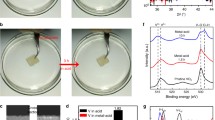Abstract.
The influence of a surface oxide on V(100) on the sticking of atomic hydrogen was studied. The oxide was produced by dosing with oxygen at different surface temperatures and characterized by AES and XPS. Thermal desorption spectroscopy was used to determine the sticking coefficient of atomic hydrogen. The kinetics of oxidation and the stability of the formed oxide have been studied in detail. The highest oxidation rate was obtained at a surface temperature of 473 K, producing a V2O3 over-layer. Although the sticking coefficient for atomic hydrogen decreases from 0.14 on the oxide free V(100) surface to 0.015 on the V2O3 surface, the sticking coefficient for atomic hydrogen was still several orders of magnitude higher than that for molecular hydrogen. This is relevant in respect of the use of the hydrogen–vanadium system for energy storage.
Similar content being viewed by others
Author information
Authors and Affiliations
Additional information
Electronic Publication
Rights and permissions
About this article
Cite this article
Schiechl, H., Winkler, A. Growth of a vanadium oxide layer on V(100) and its reactivity towards atomic hydrogen. Fresenius J Anal Chem 371, 342–347 (2001). https://doi.org/10.1007/s002160100932
Received:
Revised:
Accepted:
Published:
Issue Date:
DOI: https://doi.org/10.1007/s002160100932



